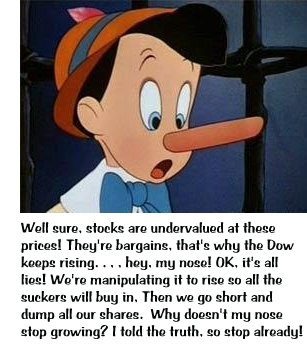

|
| weblog/wEssays archives | home | ||||||||||||||||||||||||||||||||||||||||
|
The Moon's a Balloon--And About to Pop (May 18, 2007) 
The seemingly inexorable rise in the U.S. stock indices is one of Nature's most perplexing mysteries. How does the economy weaken? Let me count the ways... housing is tanking, consumer spending is tanking, even the manipulated/phony consumer price index is rising at nearly 5% a year, gasoline is getting more expensive by the day, job "growth" is utterly bogus--but so what, the market keeps rising anyway. Ever wonder why? Well, here's your answer: so insiders can dump all their shares at the top to unsuspecting buyers who unwittingly believed the phony hype about how leveraged buyouts and the magic elixir of liquidity would support higher stock prices for the foreseeable future. Oh, and the Fed will be lowering interest rates real soon, too . . . For a view of reality as opposed to fantasy, look at the number of shares being bought by insiders (if you're an insider, and you know the stock will be rising, you buy before the public catches on) and insider sales (insiders are selling because why? They know the price will be skyrocketing soon? Hahahahaha.) My good buddy "Huevos" over at "Changos Teahouse of the Almighty" provided this summary of insider buying and selling. This metric is closely watched, because it is obvious that insiders know the prospects of their company and industry better than mere "investors"; thus if they're selling, it does not bode well for future stock market gains. In Wall Street lingo, this is called "distribution." When insiders are buying, it's called "accumulation." This is clearly distribution, on a stupendous scale.
This data makes you ask: if things are so great, why are insiders selling vast quantities of their shares and buying virtually nothing? Even in good times, insiders sell more than they buy, as stock options and grants give them "free shares" to sell. But the ratio of sells to buys is 1-to-1 or 2-to-1 in good times, not 100-to-1 or 200-to-1. Frankly, I think the "buys" in media (32,000 shares, industry-wide), Utilities (106,000 shares, industry-wide), Industrials (496,000 shares, industry-wide), transportation (250,000 shares industry-wide) and technology (1.3 million shares, industry-wide) were mistakes. An insider meant to click "sell" but accidentally clicked "buy"--a mistake that was quickly corrected. The source is Thompson Financial and the Wall Street Journal market data group. For more on this subject and a wide array of other topics, please visit my weblog. copyright © 2007 Charles Hugh Smith. All rights reserved in all media. I would be honored if you linked this wEssay to your site, or printed a copy for your own use. |
|||||||||||||||||||||||||||||||||||||||||
| weblog/wEssays | home |